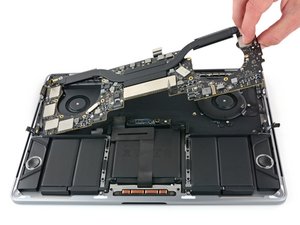By Blake Klein • Difficulty: Moderate


- Gotta love that new Mac smell, but just how new is this Pro? Get a whiff of these specs:
- 13.3” LED-backlit IPS Retina display with 2560 × 1600 resolution (227 dpi), P3 wide color gamut
- 3.1 GHz Kaby Lake dual-core Intel Core i5 (Turbo Boost up to 3.5 GHz)
- 8 GB of 2133 MHz LPDDR3 SDRAM
- 256 GB PCIe-based SSD
- Integrated Intel Iris Plus Graphics 650
- Four Thunderbolt 3 (USB-C) ports and 3.5 mm headphone port
- 802.11ac Wi-Fi and Bluetooth 4.2



- Thanks to prior experience, we've got the obnoxious suction-prying-sliding maneuver down, and we pop this little guy open in no time.
- Once the oyster is cracked, and the pearl revealed, we get some serious deja vu.
- Compare the MacBook Pro 13" Touch Bar 2017 (second)...
- ... to the MacBook Pro 13" Touch Bar 2016 (third).
- Everything looks pretty much the same to us, right down to the 49.2 Wh battery.
- The only difference we spot is the finish on the fans. Looks like the 4K iMac got the real refresh juice this year.


- We pick some cuffs out of this notebook and turn them into some mustaches. Here are the secrets within:
- Intel Core i5-7267U processor with Intel Iris Plus Graphics 650
- Intel® JHL6540 Thunderbolt™ 3 Controller
- SanDisk SDRQKBDC4 064G 64 GB NAND flash memory (x2 for a total of 128 GB on this side of the board)
- Samsung K4E6E304EB-EGCG LPDDR3 DRAM (4 x 2 GB for 8 GB total)
- Texas Instruments SN650839 power management, and TI/Stellaris LM4FS1EH SMC Controller (replacement codename for TM4EA231)
- SK Hynix H9CKNNN4GTATMR-NTH memory with custom SSD controller layered underneath (likely)
- Murata/Apple 339S00056 Wi-Fi Module

- On the opposite side we find:
- 2x SanDisk SDRQKBDC4 064G 64 GB NAND flash storage (as seen in the 2016 Escape Edition's removable SSD)—bringing the total to 256 GB
- APL1023/343S00736 (likely the custom Apple T1 chip that pairs with the Touch Bar) and (Apple?) 338S00193-A1 (probably both power management)
- 2x Texas Instruments TI CD3215C00 USB-C controller (+2 on the other side)
- Intersil ISL95828 PWM controller for Intel CPUs (likely)
- Texas Instruments HD3SS215 6.0 Gbps HDMI DisplayPort 2:1/1:2 Differential Switch
- Macronix MX25L6473EZNI-10G Serial Flash Memory
- NXP 66V10 (PN66V ?) NFC controller, containing Secure Element 008 and NXP PN549 (as seen in the iPhone 6s)


- IC Identification, continued:
- Texas Instruments TPS51980A power management and likely Renesas battery charger
- Texas Instruments TPS51916 DDR memory power supply
- Cirrus Logic/Analog Devices audio codec and amplifier (likely)
- Texas Instruments TMPxxx temperature sensor (assumption)
- Vishay SiC635 power stage
- Serial Flash and EEPROM Memory (likely)
- Apple SSD power management (assumption)

- Here's the layout, such as it is, replete with mustaches!
- For more detailed teardowns of the hardware in this device, consult the previous generation's teardown or even the past-gen one with more keys, if you fancy.
- And to round out your Mac refresh knowledge, check out our MacBook and iMac 4K teardowns.

- The MacBook Pro 13" with Touch Bar earns a 1 out of 10 on our repairability scale (10 is the easiest to repair):
- The trackpad can be removed without first removing the battery.
- Proprietary pentalobe screws continue to make working on the device unnecessarily difficult.
- The battery assembly is entirely, and very solidly, glued into the case, thus complicating replacement.
- The processor, RAM, and flash memory are soldered to the logic board.
- The Touch Bar adds a second, difficult to replace, screen to damage.
- The Touch ID sensor doubles as the power switch, and is paired with the T1 chip on the logic board. Fixing a broken power switch may require help from Apple, or a new logic board.